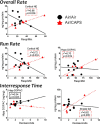Developmental exposure to concentrated ambient ultrafine particulate matter air pollution in mice results in persistent and sex-dependent behavioral neurotoxicity and glial activation
- PMID: 24690596
- PMCID: PMC4081635
- DOI: 10.1093/toxsci/kfu059
Developmental exposure to concentrated ambient ultrafine particulate matter air pollution in mice results in persistent and sex-dependent behavioral neurotoxicity and glial activation
Abstract
The brain appears to be a target of air pollution. This study aimed to further ascertain behavioral and neurobiological mechanisms of our previously observed preference for immediate reward (Allen, J. L., Conrad, K., Oberdorster, G., Johnston, C. J., Sleezer, B., and Cory-Slechta, D. A. (2013). Developmental exposure to concentrated ambient particles and preference for immediate reward in mice. Environ. Health Perspect. 121, 32-38), a phenotype consistent with impulsivity, in mice developmentally exposed to inhaled ultrafine particles. It examined the impact of postnatal and/or adult concentrated ambient ultrafine particles (CAPS) or filtered air on another behavior thought to reflect impulsivity, Fixed interval (FI) schedule-controlled performance, and extended the assessment to learning/memory (novel object recognition (NOR)), and locomotor activity to assist in understanding behavioral mechanisms of action. In addition, levels of brain monoamines and amino acids, and markers of glial presence and activation (GFAP, IBA-1) were assessed in mesocorticolimbic brain regions mediating these cognitive functions. This design produced four treatment groups/sex of postnatal/adult exposure: Air/Air, Air/CAPS, CAPS/Air, and CAPS/CAPS. FI performance was adversely influenced by CAPS/Air in males, but by Air/CAPS in females, effects that appeared to reflect corresponding changes in brain mesocorticolimbic dopamine/glutamate systems that mediate FI performance. Both sexes showed impaired short-term memory on the NOR. Mechanistically, cortical and hippocampal changes in amino acids raised the potential for excitotoxicity, and persistent glial activation was seen in frontal cortex and corpus callosum of both sexes. Collectively, neurodevelopment and/or adulthood CAPS can produce enduring and sex-dependent neurotoxicity. Although mechanisms of these effects remain to be fully elucidated, findings suggest that neurodevelopment and/or adulthood air pollution exposure may represent a significant underexplored risk factor for central nervous system diseases/disorders and thus a significant public health threat even beyond current appreciation.
© The Author 2014. Published by Oxford University Press on behalf of the Society of Toxicology. All rights reserved. For permissions, please email: journals.permissions@oup.com.
Figures











References
-
- Alessandrini F., Beck-Speier I., Krappmann D., Weichenmeier I., Takenaka S., Karg E., Kloo B., Schulz H., Jakob T., Mempel M., et al. Role of oxidative stress in ultrafine particle-induced exacerbation of allergic lung inflammation. Am. J. Respir. Crit. Care Med. 2009;179:984–991. - PubMed
-
- Banks W. A., Farr S. A., Morley J. E. Entry of blood-borne cytokines into the central nervous system: Effects on cognitive processes. Neuroimmunomodulation. 2002;10:319–327. - PubMed
Publication types
MeSH terms
Substances
Grants and funding
LinkOut - more resources
Full Text Sources
Other Literature Sources
Miscellaneous

